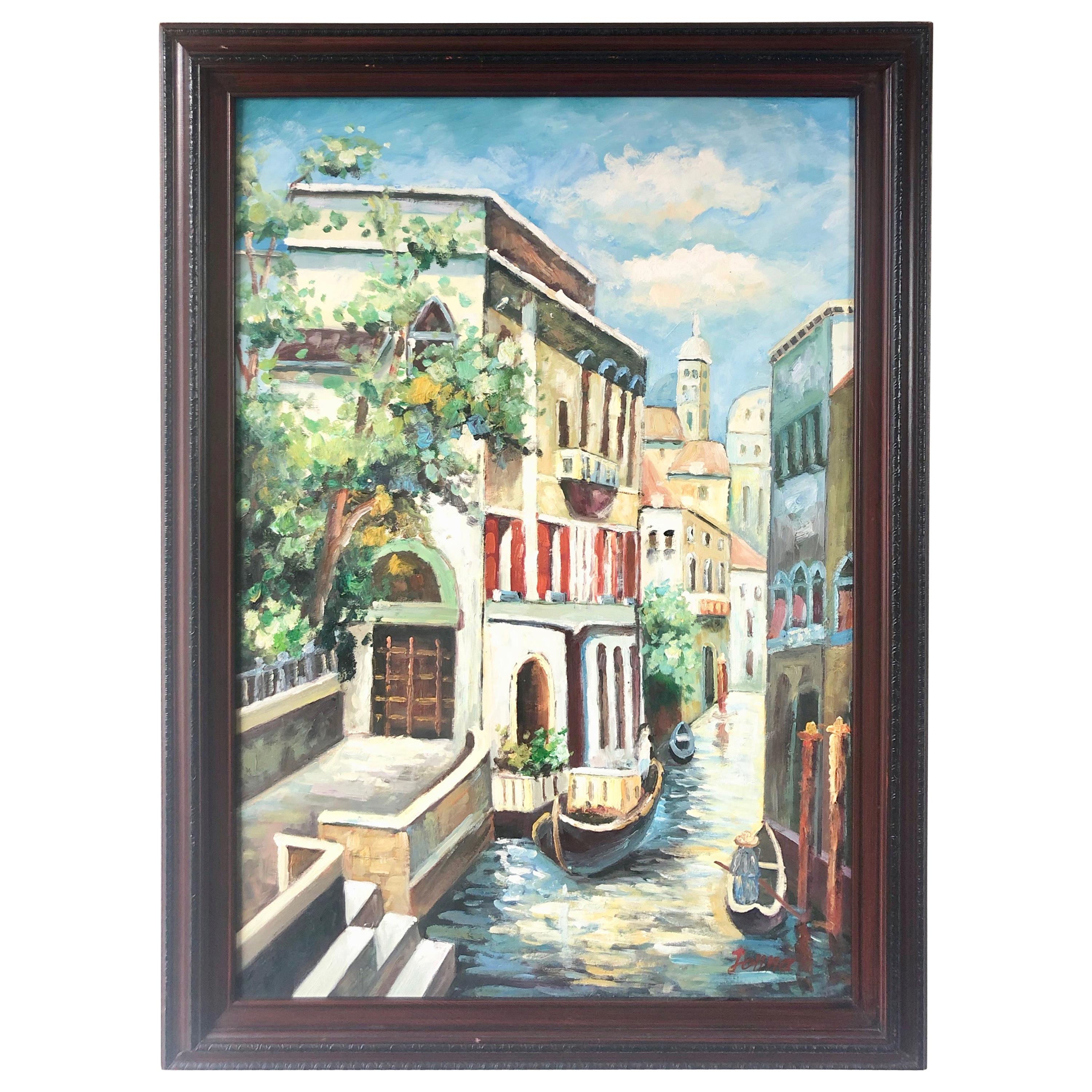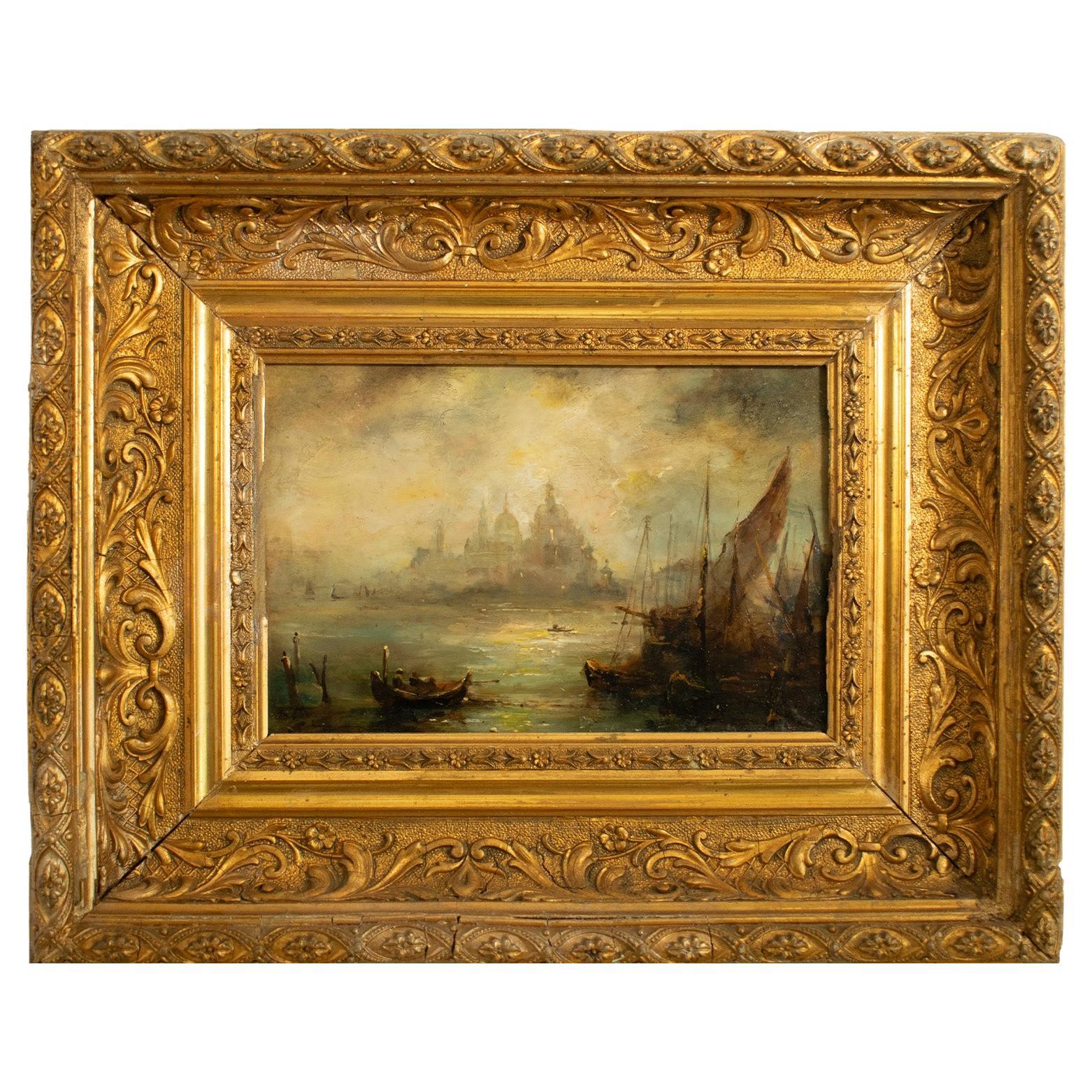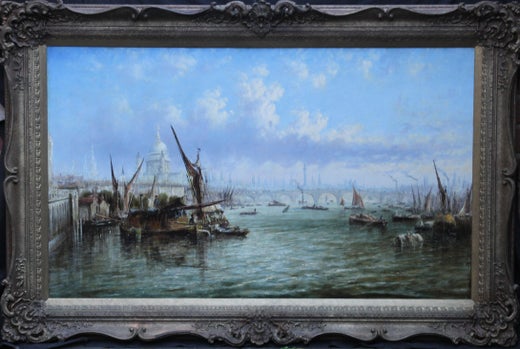Items Similar to Impressionist Painting of the Grand Canal in Venice by Francis Moltino
Video Loading
Want more images or videos?
Request additional images or videos from the seller
1 of 12
Impressionist Painting of the Grand Canal in Venice by Francis Moltino
About the Item
A signed oil on canvas of the Grand Canal in Venice by the 19th century English Italian artist Francis Moltino. Francis Moltino (1818–1874) was an Italian painter, resident in London in the mid-1840s, who specialized in landscapes and coastal scenes and was heavily influenced by his contemporary JW Turner. He exhibited at the Royal Academy between 1848 and 1855. In later life he returned to his native Italy and painted in Venice, where this painting was executed, circa 1865.
- Creator:Francis Moltino (Artist)
- Dimensions:Height: 21 in (53.34 cm)Width: 28 in (71.12 cm)Depth: 2 in (5.08 cm)
- Style:Edwardian (Of the Period)
- Materials and Techniques:
- Place of Origin:
- Period:
- Date of Manufacture:circa 1865
- Condition:Wear consistent with age and use.
- Seller Location:Vancouver, CA
- Reference Number:1stDibs: LU4631214695552
Francis Moltino
Francis Moltino was an Italian painter, resident in London, who specialized in landscapes and coastal scenes. His work is similar to that of Turner in style but with an air of southern Europe. Moltino exhibited at the Royal Academy of Arts in London between 1848–55. He was resident in Covent Garden and then Pimlico in London from the mid-1840s. In later life, Moltino returned to Italy and painted in Venice, where he might originally have come from.
About the Seller
4.9
Vetted Seller
These experienced sellers undergo a comprehensive evaluation by our team of in-house experts.
Established in 1981
1stDibs seller since 2019
139 sales on 1stDibs
Typical response time: 1 hour
- ShippingRetrieving quote...Ships From: Vancouver, Canada
- Return PolicyThis item cannot be returned.
More From This SellerView All
- Impressionist Style Painting of Le Pont Marie in Paris Signed MorganLocated in Vancouver, British ColumbiaA mid century impressionist style oil on canvas showing Le Pont Marie one of many bridges across the Seine in Paris during the fall or winter by an un documented artist who simply si...Category
Mid-20th Century French Mid-Century Modern Paintings
MaterialsCanvas
- Pair of 18 Century Paintings of St Francis Xavier and St Carlo BorromeoLocated in Vancouver, British ColumbiaA beautifully executed and rare complementary pair of oil on canvas paintings depicting two of the moist famous and important counter reformation catholic saints St Francis Xavier and St Carlo Borromeo shown in scenes of what the respective saints are mostly famous for. St Francis Xavier for the conversion to Christianity of many S. E Asian countries notably India and St Carlo Borromeo shown asking the Virgin Mary to intercede for the cessation of the terrible plague of 1576. The paintings are presented in refreshed gilded carved wooden frames and are unsigned. St. Francis Xavier was born in Spanish Navarre in 1506 and in 1528, he met St. Ignatius of Loyola. He became one of the seven in 1534 who founded the Society of Jesus (Jesuit Order). In 1536, he left the University of Paris and joined St. Ignatius in Venice. He was ordained in 1537, and in 1540 after the Society was recognized by the Pope, he journeyed to the Far East. Francis Xavier first evangelized the Portuguese colony of Goa in India, then Travancore, Ceylon, Malacca, and the surrounding islands. From there he journeyed to Japan, where he gave Christianity such deep roots that it survived centuries of violent persecution. He died on Sancian Island in 1552, while he was seeking to penetrate into the great forbidden land of China. Despite language problems, lack of funds, resistance from the Europeans as well as the natives, he persevered. St. Francis converted more people in his life than anyone since the Apostle St. Paul. He baptized over 3 million people, converted the entire town of Goa in India, and he labored in India, Pakistan, Bangladesh, Sri Lanka, Malaysia, Indonesia, Singapore, and Japan. He was truly a missionary par excellence. St Carlo Borromeo (1538-1584), was a Cardinal of the Holy Roman Catholic Church and Archbishop of Milan from 1565 to 1583. He was described in the decree for his canonization, as “a man, even while the world smiles on him with the utmost flattery, he lives crucified to the world, spiritually, trampling earthly things, seeking continuously the things of heaven, emulating the life of the Angels on earth, in his thoughts and actions. The plague began in the month of August that year. Milan was celebrating joyfully the arrival of Don John of Austria, on his way to Flanders, where he had been appointed governor. The city authorities were abuzz with excitement in their desire to bestow the highest honours on the Spanish prince, but Charles, who had been Archbishop of the diocese for six years, was following with concern the news coming from Trento, Verona and Mantua, where the plague had begun claiming victims. The first cases exploded in Milan on August 11th, right at the moment when Don John of Austria arrived. The victor of Lepanto, followed by the governor, Antonio de Guzmán y Zuñiga, departed the city, while Carlo Borromeo, who was in Lodi for the Bishop’s funeral, returned in haste. Confusion and fear reigned in Milan and the Archbishop dedicated himself completely to assisting the sick and ordering public and private prayers. Dom Prosper Guéranger sums up his infinite charity in this way: “In the absence of local authorities, he organized the health service, founded or renewed hospitals, sought money and provisions, decreed preventive measures. Most importantly though, he took steps to ensure spiritual help, assistance to the sick and the burial of the dead. Unafraid of being infected, he paid in person, by visiting hospitals, leading penitential processions, being everything to everyone, like a father and true shepherd” St. Carlo was convinced that the epidemic was “a scourge sent by Heaven” as chastisement for the sins of the people and that recourse to spiritual measures was necessary to fight against it: prayer and penitence. He rebuked the civil authorities for having placed their trust in human measures rather than divine ones. “Hadn’t they prohibited all the pious gatherings and processions during the time of the Jubilee? For him, and he was convinced of it, these were the causes of the chastisement. The magistrates who governed the city continued to oppose public ceremonies, out of fear that the large gathering of people would spread contagion, but Charles “who was guided by the Divine Spirit” – recounts another biographer – convinced them by citing various examples, among which was the one regarding St. Gregory the Great who had halted the plague devastating Rome in 590. While the pestilence spread, the Archbishop then ordered three general processions to take place in Milan on the 3rd, 5th and 6th of October, “to placate the wrath of God”. On the first day, the Saint, despite it not being the Lenten season, placed ashes on the heads of the thousands gathered, exhorting them to penitence. Once the ceremony was over, the procession went to the Basilica of St. Ambrose. Charles put himself at the head of the people, dressed in a hooded purple robe, barefoot, penitential cord at his neck and large cross in his hand. The second procession led by the Cardinal headed towards the Basilica of San Lorenzo. The third day the procession from the Duomo headed for the Basilica of Santa Maria at San Celso. St. Carlo carried in his hands a relique of Our Lord’s Holy Nail, which had been given by the Emperor Theodosius to St. Ambrose in the 5th century. The plague didn’t show any signs of waning and Milan appeared depopulated, as a third of its citizens had lost their lives and the others were in quarantine or didn’t dare leave their homes. The Archbishop ordered about twenty stone columns with a cross at the top to be erected in the main squares and city crossroads, allowing the inhabitants from every quarter to take part in the Masses and public prayers - from the windows of their homes. One of Milan’s protectors was St. Sebastian, the martyr the Romans had recourse to during the plague in 672. St. Charles suggested that the magistrates of Milan reconstruct the sanctuary dedicated to him, which was falling into ruins, and to celebrate a solemn feast in his honour for ten years. Finally in July 1577, the plague ceased and in September the founding stone was laid in the civic temple of St. Sebastian, where on January 20th every year, even today a Mass is offered to recall the end of the scourge. St.Carlo Borromeo died on November 3rd 1584 and was buried in the Duomo of Milan. His heart was solemnly translated to Rome, in the Basilica of Saints Ambrose...Category
Antique Late 18th Century French Baroque Paintings
MaterialsCanvas
- Oil Painting of the Capri Coastline by Matteo SarnoLocated in Vancouver, British ColumbiaAn early 20th century oil painting of the coastline off the Isle of Capri, near Naples painted in the impressionist style, showing rocky cliffs and the azure Mediterranean sea. The painting is titled ‘Capri’ and is signed Matteo Sarno...Category
20th Century Italian International Style Paintings
MaterialsCanvas
- Early 19 Century Italian Painting Titled "in the Market" by Giacomo PittozLocated in Vancouver, British ColumbiaA happy and colourful painting of a smiling young woman holding a basket of flowers in an open fruit and flower market. People mill around her at other tented stalls picking and choo...Category
Early 20th Century Italian Romantic Paintings
MaterialsPaint
- 19th Century Rendition of “The Blind Fiddler” in the Tate by Sir David WilkieBy Sir David WilkieLocated in Vancouver, British ColumbiaAn extremely true to the original work by Scottish-born artist Sir David Wilkie, (1785–1841) now displayed in the Tate Gallery in London The painting ...Category
Antique Late 19th Century English Georgian Paintings
MaterialsCanvas
- Original Oil Painting by the English Artist James R. WebbBy James WebbLocated in Vancouver, British ColumbiaAn atmospheric oil painting depicting a seaside with sunlit high sand dunes in the forefront and in Stark contrast a dark stormy sky in the background with seagulls overhead. Small sailing ships can be seen in the distance. Climbing the dunes is a shepherdess and her small flock of sheep grazing on meagre offerings along the dunes. A young couple can also be seen sitting on the beach in the background. The painting is in its original carved and gilded frame. Signed James Webb and dated 18_7 on the bottom right hand corner of the canvas. Why the artist omitted the "decade" digit and put an underscore instead is a mystery. The painting is set in an intricately carved gilded frame which has been professionally restored. James R Webb...Category
Antique Late 19th Century British Victorian Paintings
MaterialsCanvas
You May Also Like
- Grand Canal of Venice WatercolorBy Cecil BeatonLocated in West Palm Beach, FLThis stylish and beautiful watercolor of the Grand Canal of Venice was painted by Cecil Beaton and dates to the 1920s. The piece was acquired from a Pa...Category
Early 20th Century Italian Romantic Paintings
MaterialsPaper
- Manner of J.M.W Turner, Venice Scene of the Grand Canal PaintingLocated in Nashville, TNProbably circa 1910, decorative painting with craquelure throughout. Old dark varnish. The sky near frame edge has thicker paint suggesting some later in painting. Stretcher marks sh...Category
Vintage 1910s Italian Paintings
- Canals of Venice Painting Signed "Jonna"Located in Denton, TXCanals of Venice painting believed to be painted by Jonna Tratner. This piece is signed.Category
Mid-20th Century American Paintings
MaterialsCanvas, Wood, Paint
- The Entrance to the Grand Canal, Venice - exquisite oil on panelLocated in TEYJAT, FRThe Entrance to the Grand Canal, Venice - exquisite oil on panel, unsigned. This is a superb oil painting of one of the most famous scenes in Venice, dated around the mid 18th centu...Category
Antique Mid-18th Century European Paintings
MaterialsWood
- Antique Oil Painting Grand Canal Ducal Palace Venice Alfred Pollentine 1882By Alfred PollentineLocated in London, GBThis is a beautiful oil on canvas painting of the view of the Ducal Palace and the entrance to the Piazza San Marco Canal in Venice by the renowned British artist Alfred Pollentine (1836-1890) and signed lower right 'A Pollentine/82. This beautiful landscape captures a striking view of the Ducal Palace from across the Grand Canal. It features a busy canal scene with sailing boats and gondoliers in the foreground, in the distance the facades of Saint Mark's, the Doge's Palace, Santa Maria della Salute and the spiralling tower of the San Marco Campanile complete the painting. Housed in it's original and beautiful gilt gallery frame. Several examples of his work have sold at top auction...Category
Antique 1880s British Paintings
MaterialsCanvas
- Antique Oil Painting Grand Canal Venice Alfred Pollentine 19th CenturyBy Alfred PollentineLocated in London, GBThis is a beautiful oil on canvas painting of the view of the The Grand Canal in Venice by the renowned British artist Alfred Pollentine (1836-1890) and signed lower right 'A Pollentine, 19th century in date. This beautiful landscape captures a striking view of the Grand Canal, it features a busy canal scene with gondoliers in the foreground, in the distance the facades of Saint Mark's complete the painting. Housed in it's original and beautiful gilt gallery frame. Several examples of his work have sold at top auction...Category
Antique 19th Century English Paintings
MaterialsCanvas
Recently Viewed
View AllMore Ways To Browse
Grand Canal Oil Painting
Painting Grand Canal Venice
Edwardian Oil Paintings
Antique Colonial Signs
After Boucher
Acrylic Panel Paintings
Framed Impressionism
Pair Antique Landscape Paintings
Tree Of Life Wall Art
Portraits Xvi Century
Turner Wall Light
Buffalo Artist
Used Furniture San Marcos
18th Century Italian Religious Paintings
Pair Of Antique Landscape Paintings
Pair Large Antique Paintings
Antique Photos Women
Antique Women Photos






